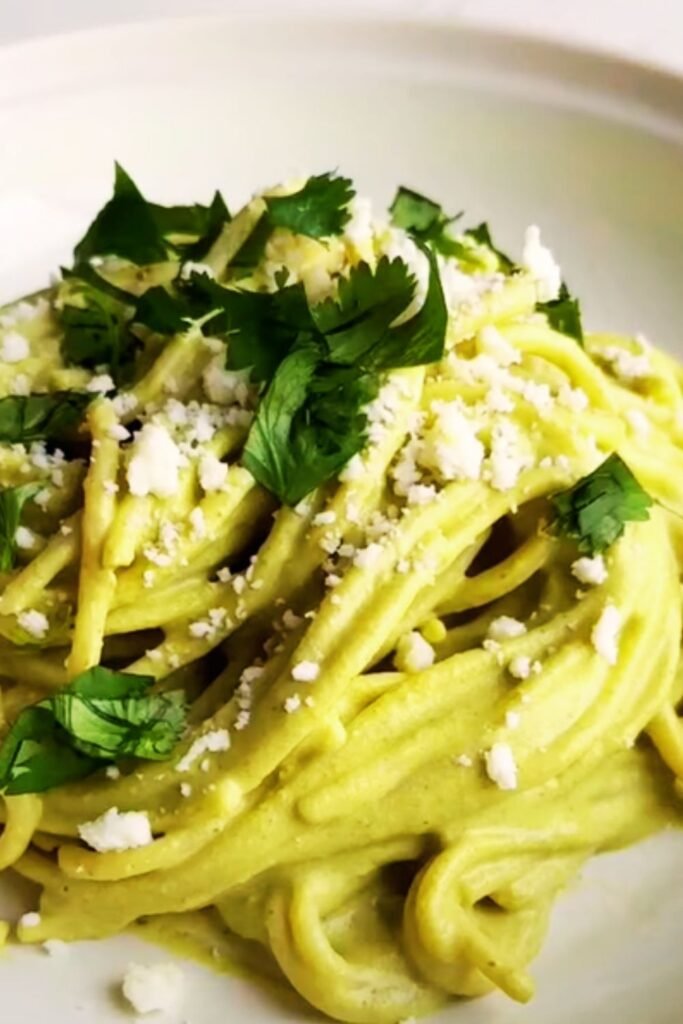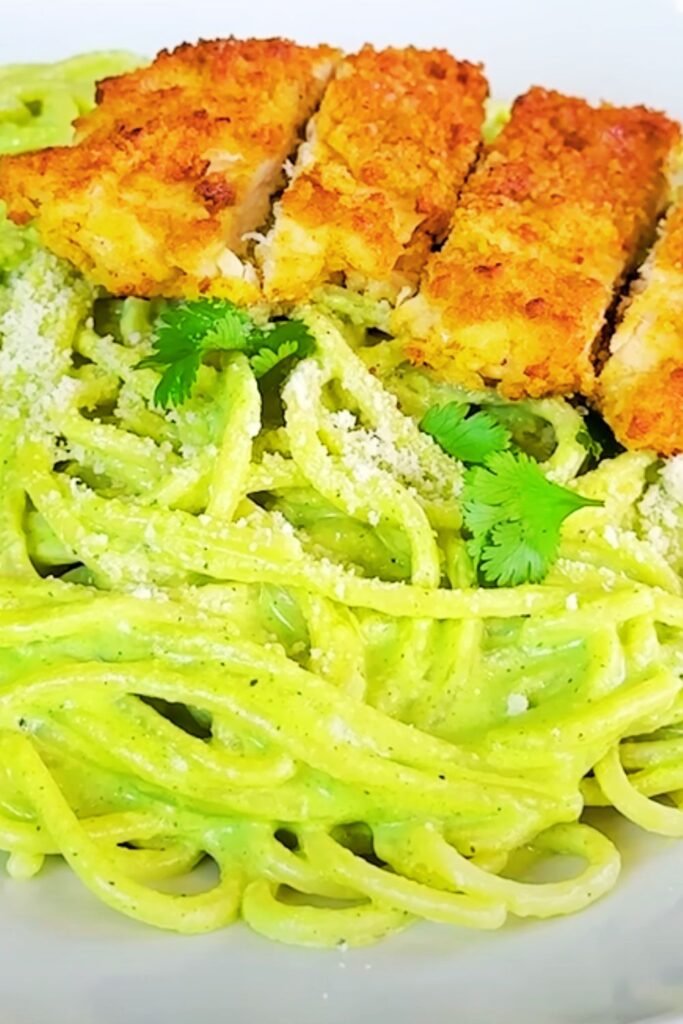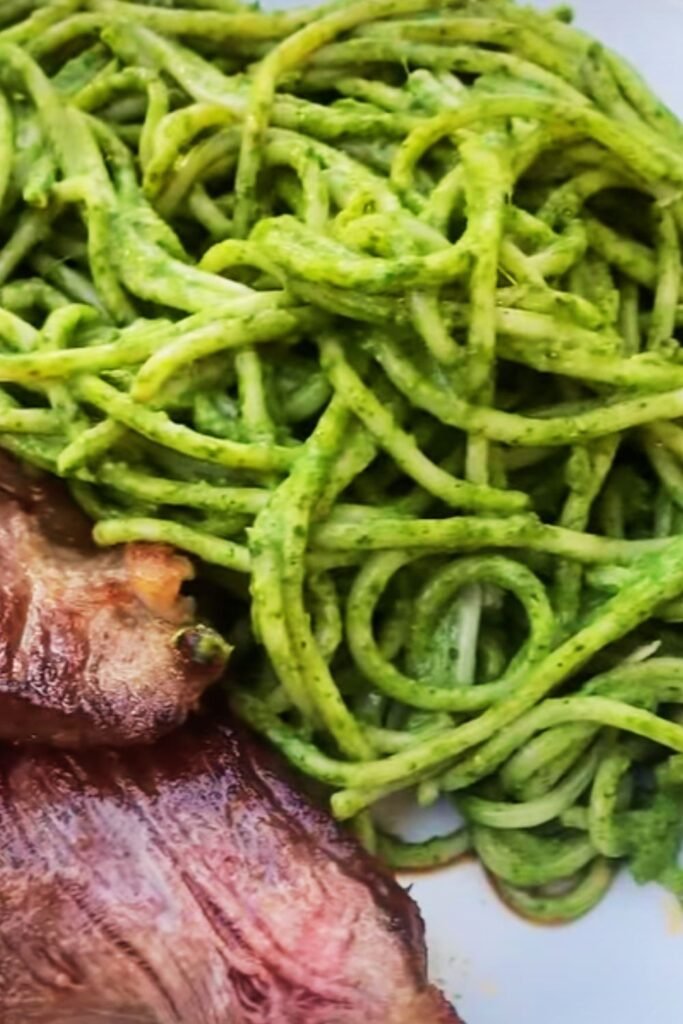When I first discovered Peruvian green spaghetti, or tallarines verdes as it’s lovingly called in Peru, my world of pasta dishes completely transformed. This vibrant, herbaceous creation isn’t your typical Italian fare – it’s a beautiful fusion that tells the story of Peru’s rich culinary heritage, where Italian immigration met indigenous ingredients to create something absolutely magical.
I remember the first time I tasted this dish at a small family-run restaurant in Lima. The emerald-green sauce clung perfectly to each strand of pasta, and the aroma of fresh basil, spinach, and cilantro filled my senses before I even took my first bite. That moment changed everything I thought I knew about pasta, and I knew I had to master this recipe to share with my own family.
The Heart and Soul of Tallarines Verdes
Tallarines Verdes: A beloved Peruvian pasta dish featuring spaghetti tossed in a vibrant green sauce made primarily from basil, spinach, cilantro, and cheese, often served with grilled steak or chicken.
Pesto Peruano: The green sauce base that differs from traditional Italian pesto by incorporating spinach, cilantro, and sometimes milk or evaporated milk for creaminess.
Fusion Cuisine: The beautiful blending of Italian pasta-making techniques with Peruvian ingredients and flavors, representing the multicultural influence in Peruvian cooking.
What makes this dish so special isn’t just its stunning appearance – though that bright green color never fails to impress dinner guests. It’s the way the sauce combines familiar Italian elements like basil and garlic with distinctly Peruvian touches like cilantro and sometimes a hint of ají amarillo (yellow chili peppers). The result is a pasta dish that’s both comforting and exotic, familiar yet surprising.
My Journey to Perfect the Recipe
I’ve spent countless hours perfecting this recipe, testing different ratios of herbs, experimenting with various cheeses, and adjusting cooking techniques. Through trial and error, I’ve discovered the secrets that make this dish restaurant-quality every single time. The key lies in understanding that this isn’t just Italian pesto with a green twist – it’s an entirely different sauce with its own personality and requirements.

The beauty of tallarines verdes lies in its versatility. I’ve served it as a weeknight dinner for my family, prepared it for special occasions with guests, and even packed it for picnics (it’s surprisingly good at room temperature). Each time, it receives rave reviews and requests for the recipe.
Essential Ingredients for Authentic Flavor
Creating authentic Peruvian green spaghetti requires specific ingredients that work together to create that distinctive flavor profile. Here’s what you’ll need:
Primary Sauce Ingredients
| Ingredient | Amount | Purpose | Substitution Notes |
|---|---|---|---|
| Fresh Basil | 2 cups packed | Primary herb base | Use only fresh, never dried |
| Fresh Spinach | 1 cup packed | Color and earthiness | Baby spinach works best |
| Fresh Cilantro | 1/2 cup | Distinctive Peruvian touch | Essential for authentic flavor |
| Garlic Cloves | 4-6 cloves | Aromatic foundation | Adjust to taste preference |
| Queso Fresco | 6 oz | Creamy texture | Ricotta or farmer’s cheese |
| Parmesan Cheese | 1/2 cup grated | Sharp, nutty flavor | Pecorino Romano works |
| Evaporated Milk | 1/2 cup | Smooth consistency | Whole milk or heavy cream |
| Olive Oil | 1/4 cup | Richness and emulsification | Extra virgin preferred |
| Pine Nuts | 1/4 cup | Traditional nuttiness | Walnuts or cashews |
Pasta and Accompaniments
| Component | Amount | Notes |
|---|---|---|
| Spaghetti | 1 lb | Use quality pasta for best texture |
| Salt | For pasta water | Generously salt the water |
| Black Pepper | To taste | Freshly ground preferred |
| Optional Protein | 1-2 lbs | Grilled steak or chicken |
Step-by-Step Preparation Method
Preparing the Green Sauce
I always start with the sauce because it’s the star of this dish. The order of operations matters here, and I’ve learned that rushing this process never yields the best results.
Herb Preparation: Begin by washing all your fresh herbs thoroughly. I cannot stress enough how important it is to use completely dry herbs – excess water will make your sauce watery and affect the final consistency. After washing, I spin the herbs in a salad spinner and then pat them dry with paper towels.
Blanching Technique: Here’s where my recipe differs from many others I’ve seen. I briefly blanch the spinach in boiling water for just 30 seconds, then immediately plunge it into ice water. This process, called shocking, helps maintain that brilliant green color and removes any bitter undertones from the spinach.

The Blending Process: In a food processor or high-powered blender, I combine the basil, blanched spinach, cilantro, and garlic first. Pulse several times to begin breaking down the herbs, then slowly drizzle in the olive oil while the machine runs. This gradual addition creates a better emulsion.
Next comes the cheese integration. I add both the queso fresco and Parmesan, processing until smooth. The evaporated milk goes in last, and I blend just until everything is well combined. Over-processing at this stage can make the sauce grainy.
Pasta Cooking Excellence
While many home cooks treat pasta cooking as an afterthought, I’ve learned that properly cooked pasta makes or breaks this dish. I use a large pot with plenty of water – at least 4 quarts for one pound of pasta. The water should be as salty as seawater; this is your only chance to season the pasta itself.
I cook the spaghetti until it’s just shy of al dente, usually 1-2 minutes less than the package directions suggest. The pasta will finish cooking when I toss it with the hot sauce, and this technique prevents overcooking.
Pasta Water Magic: Before draining the pasta, I reserve at least one cup of the starchy pasta cooking water. This liquid gold will help bind the sauce to the pasta and adjust the consistency if needed.
Bringing It All Together
This is where the magic happens. In a large skillet or sauté pan over medium heat, I warm the green sauce gently. It’s crucial not to boil the sauce, as this can cause the cheese to separate and the milk to curdle.
I add the slightly undercooked pasta directly to the pan with the sauce, along with about 1/4 cup of the reserved pasta water. Using tongs, I toss everything together, allowing the pasta to finish cooking in the sauce. This technique, called “mantecatura” in Italian cooking, creates a cohesive dish where the sauce clings to every strand of pasta.
If the mixture seems too thick, I gradually add more pasta water until I achieve the perfect consistency – the sauce should coat the pasta without being gluey or watery.
Nutritional Profile and Health Benefits
One of the things I love about this dish is how nutritious it is despite being incredibly satisfying. The abundance of fresh herbs provides numerous health benefits:
Nutritional Breakdown (Per Serving)
| Nutrient | Amount | % Daily Value |
|---|---|---|
| Calories | 485 | 24% |
| Protein | 18g | 36% |
| Carbohydrates | 58g | 19% |
| Fiber | 4g | 16% |
| Fat | 20g | 31% |
| Calcium | 285mg | 28% |
| Iron | 3.2mg | 18% |
| Vitamin K | 245mcg | 204% |
| Folate | 88mcg | 22% |
Health Benefits of Key Ingredients
Basil: Rich in antioxidants and anti-inflammatory compounds, basil supports immune system health and may help reduce stress levels.
Spinach: Packed with iron, folate, and vitamin K, spinach supports bone health and energy production.
Cilantro: Contains compounds that may help with heavy metal detoxification and provides vitamin C for immune support.
Garlic: Known for its cardiovascular benefits and natural antimicrobial properties.
The combination of these nutrient-dense herbs with quality pasta and cheese creates a well-balanced meal that satisfies both nutritional needs and taste preferences.
Serving Suggestions and Pairings

In Peru, tallarines verdes is traditionally served alongside grilled meats, particularly bistec a la parrilla (grilled steak) or pollo a la brasa (rotisserie chicken). However, I’ve discovered numerous delicious pairing options that work beautifully with this versatile dish.
Traditional Accompaniments
- Grilled Steak: A perfectly seasoned and grilled steak provides protein and a wonderful textural contrast to the creamy pasta
- Roasted Chicken: Whether it’s a whole roasted chicken or grilled chicken thighs, poultry pairs beautifully with the herb-forward sauce
- Pan-seared Fish: Light white fish like sea bass or mahi-mahi complement without overwhelming the delicate herb flavors
Vegetarian Options
- Grilled Portobello Mushrooms: Meaty mushrooms provide satisfying texture and earthy flavors
- Roasted Vegetables: Bell peppers, zucchini, and eggplant create a colorful and nutritious meal
- White Beans: Cannellini or navy beans add protein and fiber while maintaining the dish’s comfort food appeal
Side Dishes That Shine
- Simple Green Salad: A light salad with citrus vinaigrette cuts through the richness of the pasta
- Garlic Bread: Traditional but always welcome, especially when made with Peruvian-style crusty bread
- Roasted Cherry Tomatoes: Their natural sweetness and acidity provide a perfect flavor balance
Storage and Reheating Tips
One question I frequently receive is about storing and reheating this dish. The good news is that Peruvian green spaghetti keeps well and reheats beautifully when done correctly.
Storage Guidelines
| Storage Method | Duration | Quality Notes |
|---|---|---|
| Refrigerator | 3-4 days | Best quality within 2 days |
| Freezer | Up to 3 months | Sauce may separate slightly |
| Room Temperature | Maximum 2 hours | Food safety concern beyond this |
Reheating Methods
Stovetop Method (My Preferred Choice): Place the pasta in a large skillet over medium-low heat. Add 2-3 tablespoons of water, milk, or cream to help reconstitute the sauce. Stir gently and heat through, about 5-7 minutes.
Microwave Method: Place pasta in a microwave-safe dish, add a splash of liquid, cover, and heat in 30-second intervals, stirring between each interval.
Oven Method: For larger quantities, place pasta in a covered baking dish with added liquid and reheat at 350°F for 15-20 minutes.
Troubleshooting Common Issues
Through years of making this dish, I’ve encountered and solved various challenges that home cooks often face:
Sauce Too Thick
If your sauce becomes too thick, gradually stir in pasta water, milk, or cream until you reach the desired consistency. This often happens if the pasta absorbs too much sauce during storage.
Sauce Separates
This usually occurs from overheating. Always reheat on low to medium-low heat, and consider adding a tablespoon of cream or milk to help re-emulsify.
Color Fading
The vibrant green color can fade over time or with excessive heat. To maintain color, avoid boiling the sauce and store it properly covered in the refrigerator.
Bland Flavor
If the dish tastes flat, it likely needs more salt, freshly ground black pepper, or a squeeze of fresh lemon juice to brighten the flavors.
Cultural Significance and Personal Memories
Every time I prepare this dish, I’m reminded of the incredible story it tells about Peruvian cuisine. The Italian immigrants who arrived in Peru in the late 19th and early 20th centuries didn’t simply transplant their recipes – they adapted them using local ingredients and techniques, creating something entirely new and wonderful.
This fusion represents what I love most about cooking: the way food evolves, travels, and transforms while maintaining its essential soul. When I serve this pasta to my family, I’m not just providing a meal; I’m sharing a piece of culinary history and cultural exchange.
The first time I made this for my children, they were skeptical about the green color. But after one bite, they were asking for seconds and requesting it for their birthday dinners. It’s become our family’s signature dish for special occasions, and I love how it brings everyone together around the dinner table.
Variations and Adaptations
Over the years, I’ve developed several variations of this basic recipe to accommodate different tastes and dietary needs:
Protein Additions
- Shrimp: Pan-seared shrimp makes an elegant variation
- Italian Sausage: Crumbled and browned, it adds a hearty element
- Pancetta: Crispy bits provide a salty, smoky contrast
Dietary Modifications
- Gluten-Free: Use quality gluten-free pasta; the sauce naturally accommodates this dietary need
- Dairy-Free: Substitute nutritional yeast for cheese and use coconut milk instead of evaporated milk
- Lighter Version: Reduce the olive oil and substitute Greek yogurt for some of the cheese
Seasonal Twists
- Summer: Add cherry tomatoes and fresh corn
- Fall: Incorporate roasted butternut squash
- Winter: Include sautéed mushrooms and caramelized onions
Questions & Answers
Q: Can I make the green sauce ahead of time? Absolutely! I often prepare the sauce up to 3 days in advance and store it in the refrigerator. The flavors actually improve as they meld together. Just bring it to room temperature before using and thin with a little milk or pasta water if needed.
Q: What’s the best substitute for queso fresco if I can’t find it? Ricotta cheese is my go-to substitute – it has a similar mild flavor and creamy texture. Farmer’s cheese or even cream cheese (use less) can work in a pinch. The key is using a mild, creamy cheese that won’t overpower the herbs.
Q: Why does my sauce turn brown instead of staying bright green? This usually happens when the herbs are exposed to too much heat or air. Make sure to blanch and shock your spinach, keep everything cold during processing, and avoid overheating the sauce when combining with pasta. Using completely fresh herbs also makes a significant difference.
Q: Can I freeze the green sauce separately? Yes, the sauce freezes well for up to 3 months. I recommend freezing it in ice cube trays for easy portioning, then transferring to freezer bags. Thaw overnight in the refrigerator and stir well before using.
Q: How do I prevent the pasta from becoming mushy when reheating? The key is to slightly undercook the pasta initially and add liquid when reheating. Use low heat and stir gently. If the pasta seems overcooked, try adding it to a hot skillet with a little olive oil for a quick sauté to restore some texture.
Q: Is it normal for the sauce to separate in the refrigerator? Some separation is normal, especially if you’ve used evaporated milk. Simply stir the sauce before using, and it should come back together. If it doesn’t, a quick blend in the food processor or a vigorous whisk usually fixes it.
Q: Can I add other herbs to the sauce? While basil, spinach, and cilantro are traditional, I sometimes add a small amount of fresh parsley or even mint for variation. Start with small amounts – about 2 tablespoons – as these herbs can be quite strong.
Q: What’s the secret to getting the sauce to stick to the pasta properly? The key is finishing the pasta in the sauce with some reserved pasta water. The starch from the pasta water acts as a natural binding agent. Also, make sure your pasta is slightly undercooked when you add it to the sauce, allowing it to absorb the flavors as it finishes cooking.
This incredible dish has become more than just a recipe in my kitchen – it’s a bridge between cultures, a celebration of fusion cuisine, and a testament to how food can bring families together. Whether you’re looking to expand your culinary horizons or simply want to surprise your family with something deliciously different, Peruvian green spaghetti delivers on every level.
The first time you twirl those emerald-green strands around your fork and taste the perfect balance of fresh herbs, creamy cheese, and perfectly cooked pasta, you’ll understand why this dish has captured hearts across Peru and beyond. I encourage you to make this recipe your own, adjusting the herbs and seasonings to match your family’s preferences while respecting the beautiful tradition that created this culinary masterpiece.